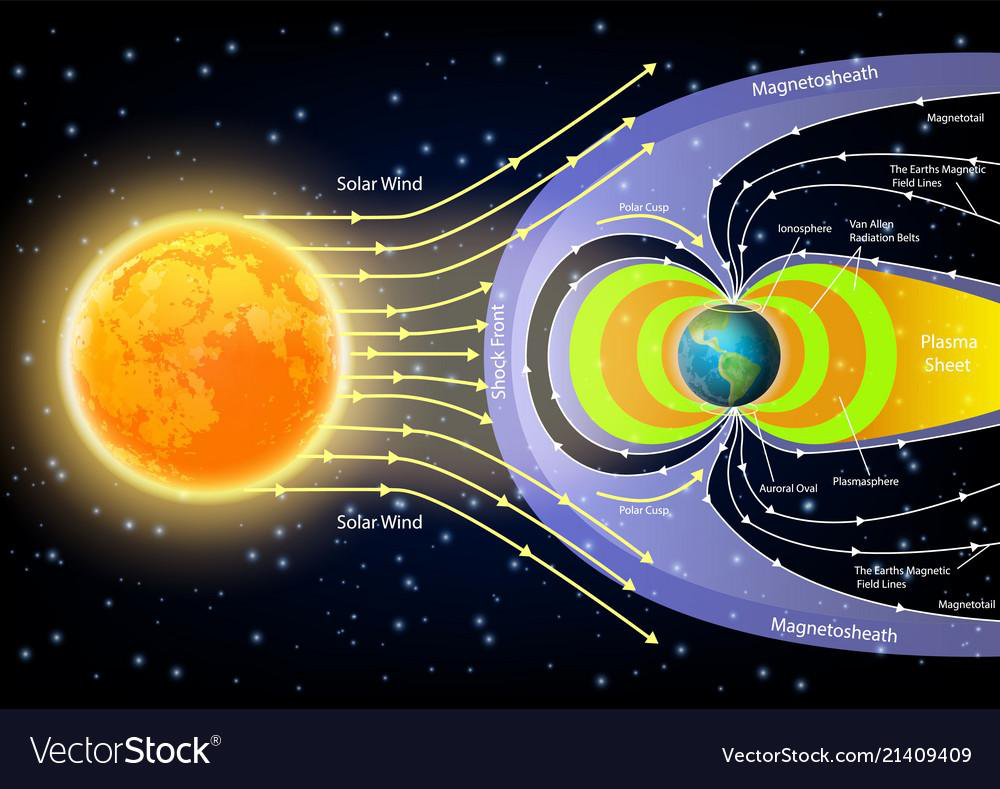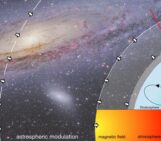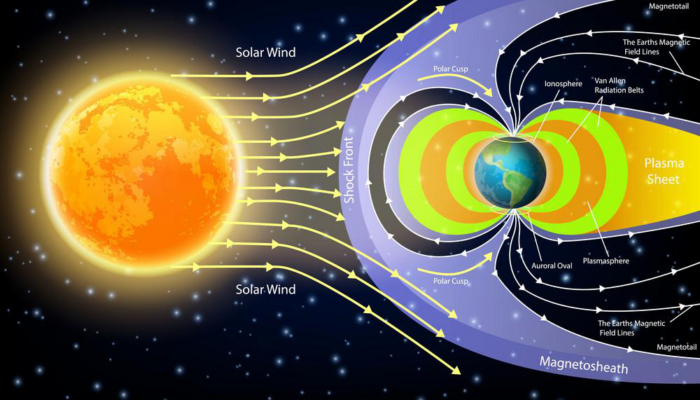
Particle Precipitation
High energy particles (e.g. electrons and protons) that precipitate at high latitudes can alter the chemical composition of the atmosphere by different photochemical reactions. This mainly happens due to primary collision processes and subsequent ion and neutral-chemistry reactions. Such reactions ordered by increasing energy are, for example, excitation, photo-dissociation, photo-ionization and dissociative ionization. These particles can come from various sources in outer space, accelerated by different processes to varied energies, and they affect different altitude ranges of the atmosphere. Such sources are, for example, galactic cosmic rays (GCRs), with protons and heavier nuclei of energies ranging from hundreds of MeV to GeV; coronal mass ejections and solar proton events (SPEs) with protons of energies from MeV to GeV; auroral electrons during substorms accelerated to energies from 10 keV to hundreds of keV; and medium and high energy electrons in the radiation belts to energies from tens of keV into the MeV range. This study involves SPEs which can also induce geomagnetic disturbances in the Earth’s magnetosphere leading to energetic electron precipitation (EEP) events. Recent studies, such as Verronen et al. (2005), that studied energetic particle precipitation events (EPP) found significant co-variability in mesospheric ozone with proton and electron fluxes. Certain chemical species cannot be reproduced using the standard parameterization of odd oxides of hydrogen, HOx and odd oxides of nitrogen, NOx production, while models considering D-region ion-chemistry in detail agree with the observations. In our recent study (Borthakur et al., 2023), we are mainly concerned with solar proton events. Reduced ozone levels as a result of ozone depletion means more exposure to UV radiation which has various effects on human health. We analysed solar proton events to see what influence it has on the chemistry of the earth’s atmosphere and how this atmospheric chemistry change can affect the ozone. To do that we used an atmospheric 1D stacked box model, considering only chemistry and compared it with satellite data. The focus was mainly on the contribution of chlorine ions on ozone loss. The chlorine ions can influence the neutral chlorine compounds which can directly destroy so much of ozone through their catalytic cycles. Chlorine initiates the breakdown of ozone and combines with a freed oxygen to create two oxygen molecules. After each reaction, chlorine begins the destructive cycle again with another ozone molecule. One chlorine atom can thereby destroy thousands of ozone molecules. Because ozone molecules are being broken down they are unable to absorb any ultraviolet light so we experience more intense UV radiation at the earths surface. Exposure to UV rays can cause premature aging of the skin and signs of sun damage such as wrinkles, leathery skin and liver spots. UV rays can also cause eye problems. They can cause the cornea (on the front of the eye) to become inflamed or burned. They can also lead to the formation of cataracts (clouding of the lens of the eye) which can impair vision and can weaken the immune system, so that the body has a harder time fending off infections.
Evaluation of the model with MIPAS observations
The Michelson Interferometer for Passive Atmospheric Sounding (MIPAS) was a Fourier transform spectrometer for the detection of mid-infrared limb emission spectra in the middle and upper atmosphere on the ENVISAT (Environmental Satellite, 2000) mission (Fischer et al. (2008)). ENVISAT was launched in 2002 into a sun-synchronous polar orbit (800 km) and stopped operation in April 2012.
We use state of the art 1D stacked-box Exoplanetary Terrestrial Ion Chemistry model (ExoTIC) of atmospheric ion and neutral composition to investigate solar proton events in the Northern Hemisphere (NH). The Halloween SPE that occurred in late October 2003 was used as a test field for our study. Our main purpose is to use such a large event that has been recorded by MIPAS on ENVISAT to evaluate the performance of the ion-chemistry model. The model simulations were performed in the Northern Hemisphere at a high latitude of 67.5◦N, inside the polar cap because the impact of such energetic events is highly visible in the polar regions. Comparison of the simulated effects against MIPAS observations for the Halloween SPE revealed a rather good temporal agreement, also in terms of altitude range for different chemical species that we studied, for e.g. HOCl, O3, ClONO2 and odd oxides of nitrogen, NOy. We applied MIPAS averaging kernels to the model profiles to adjust the vertical resolution between the model and MIPAS data. This is because, what MIPAS sees is a distorted picture of the ”truth”. We apply the same distortion to the model data when applying the averaging kernels. If averaging kernel convolved model results and MIPAS observations fit, then the original model results represent the ”truth”. Therefore, the MIPAS results do not represent the true distribution of trace gases in the atmosphere, but the original model result. We perform three different sensitivity runs to see which one agrees best with the observations, mainly comparing the runs with D-region ion-chemistry to NOx and HOx parameterisation. To see the impact of the included chlorine ions on different species in the ion-chemistry model, we switched it off. Figures 1 and 2 show results for HOCl and ozone for nighttime during the Halloween SPE. The study is shown only for a short period of time because the ExoTIC 1D model contains only chemistry and no transport. It can be seen from the figures that the the ion-chemistry model agreed best with the observations. The averaging kernel impact is seen quite clearly for the HOCl species.
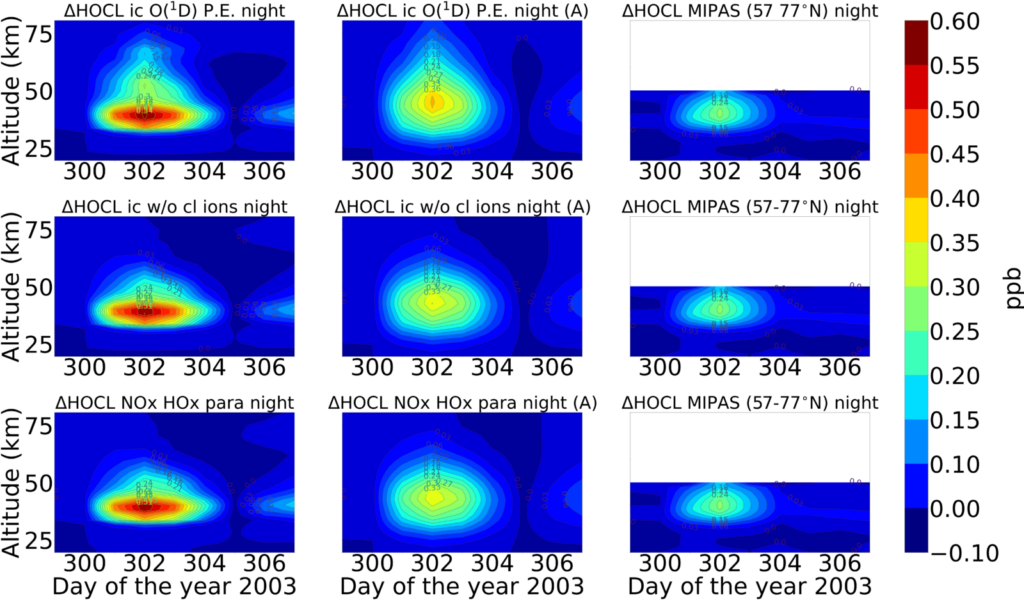
Figure 1. Absolute differences of daily averaged data for HOCl w.r.t. a day before the event, i.e. 26th October 2003. For the three different model settings (Sensitivity tests (row-wise): ion-chemistry where we set O(1D) in photo-chemical equilibrium, switching off chlorine ion-chemistry and parameterised NOx and HOx); column-wise: without Averaging kernal (A), with Averaging kernal (A) applied and MIPAS observations averaged over 57-77◦N for night-time (Image source: Borthakur et al., 2023).
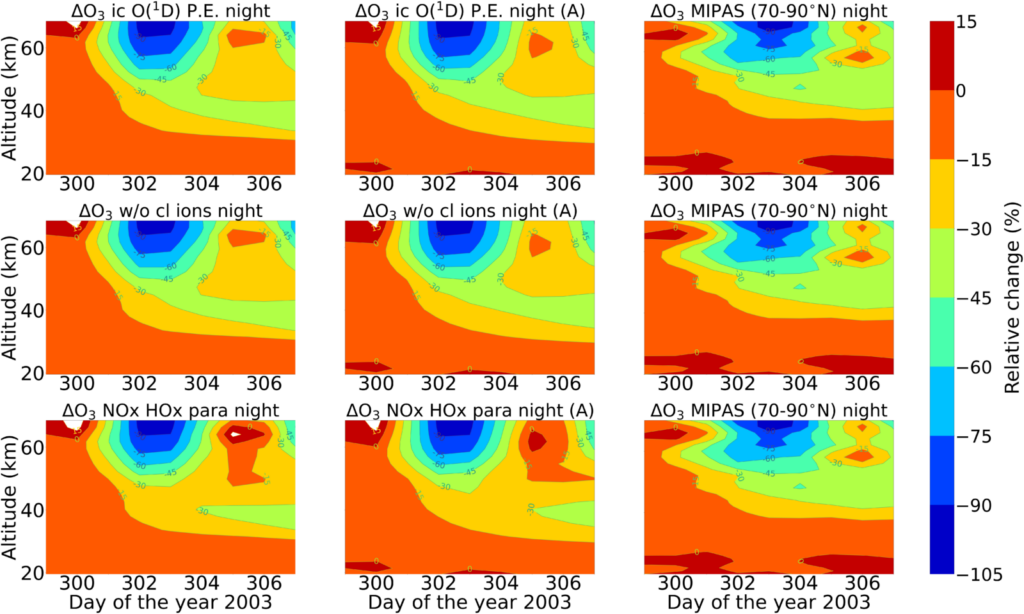
Figure 2. Relative differences of daily averaged data for O3 w.r.t. a day before the event. Rest is same as figure 1 except MIPAS observations are averaged over 70-90◦N (Image source: Borthakur et al., 2023).
Comparing the Halloween SPE with an extreme solar event
With the validated model applied to an extreme solar event of 775 A.D., an assessment was made about what is to be expected at worst for effects of a SPE on the middle atmosphere concentrating on effects of ion-chemistry compared to crude parameterisations. We conducted a systematic analysis comparing the impact of the Halloween SPE and the extreme event on the Earth’s middle atmosphere. As seen from the model simulations, both events were able to perturb the polar stratosphere and mesosphere, with a high production of NOy and HOx. Longer lasting and stronger stratospheric ozone loss was seen for the extreme event. An example showing ozone loss during the events is shown
in figure 3.
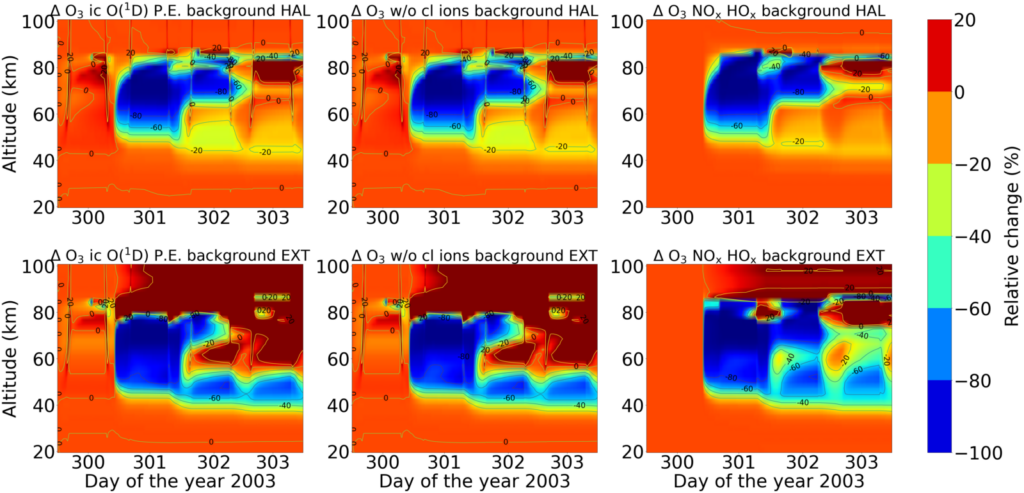
Figure 3. Percentage difference of ozone for the different model runs w.r.t. the reference run (row-wise): Halloween event and extreme scenario; (column-wise): ion-chemistry with O(1D) set to photo-chemical equilibrium, switching off the included Cl ions and parameterised NOx and HOx (Image source: Borthakur et al., 2023).
Impact of chlorine ions on ozone loss
The evaluation of the model results with MIPAS observations gave us confidence in the model. Thus, the impact of chlorine ion-chemistry on ozone loss could be assessed using the model, according to which, we found the ozone loss in the stratosphere and lower mesosphere during the event. Figure 4 shows the relative difference of the ion-chemistry model with O(1D) in photo-chemical equilibrium including chlorine ions w.r.t. the model without chlorine ions for daytime and nighttime. The difference in this case here is calculated for daily averaged data for each day. Chlorine ion chemistry causes an extra loss of 2.5 % during daytime at an altitude range of 40-60 km and about 10 % during nighttime, at an altitude of 50-70 km was observed during the event day. Negative chlorine species directly increase the concentrations of uncharged active chlorine compounds. Through their catalytic cycles, these uncharged chlorine compounds can be responsible for ozone loss at different altitudes which is also dependent on illumination conditions. Figure 5 shows the relative differences of the model setting with ion-chemistry and O(1D) in photo-chemical equilibrium w.r.t. the model setting without chlorine ion-chemistry comparing the Halloween SPE and the extreme event in order to assess the impact of chlorine ion-chemistry on ozone loss during the event day. An impact of the chlorine ions around 10-20% is observed on the event day. Qualitatively, it was a bit more for the extreme event compared to the Halloween SPE that could be more important for higher forcing. An increase of around 5% for ozone is also seen after the event ends, in the case of the extreme scenario.

Figure 4: Relative difference of the model with full ion-chemistry and O(1D) in photo-chemical equilibrium including chlorine ions w.r.t. the model without chlorine ion-chemistry for the Halloween SPE: daytime (left) and nighttime (right). The difference here is calculated for daily averaged data (Image source: Borthakur et al., 2023).
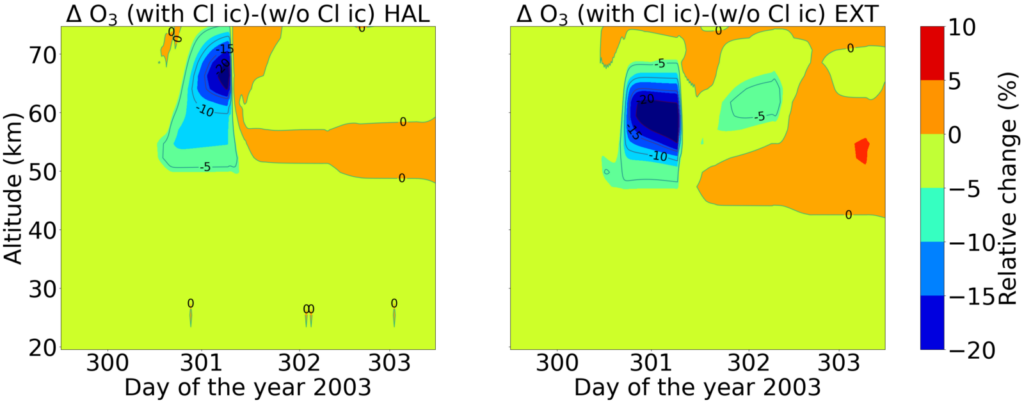
Figure 5: Relative difference of the model simulations: full ion-chemistry with O(1D) in photo-chemical equilibrium and with chlorine ions w.r.t. the model setting without chlorine ion-chemistry comparing the Halloween SPE (left) and extreme scenario (right). The data shown here is not daily averaged but the real model time step (Image source: Borthakur et al., 2023).
Conclusions and implications of our work
In general, ExoTIC simulations reproduced the impacts of the Halloween SPE quite well, mainly for HOCl, ozone and NOy. However, the initial state of the atmosphere in the simulations could be an important factor for some variability in the model results and MIPAS observations. While previous results with UBIC focused on the solar proton event in July 2000 in the northern polar region and compared to the HCl measurements from Halogen Occultation Experiment instrument (HALOE), we compare with MIPAS observations. Since MIPAS observations provide a better picture of the polar cap region as compared to HALOE observations that are less densely sampled, these results suggest that the validated D-region ion-chemistry setup in the ExoTIC model can be trusted to implement in a global 3D model. One can conclude that models considering the D-region ion-chemistry also compare much better to observations. Perturbation of the polar stratosphere and mesosphere, with a high production of NOy and HOx was found for the extreme event of 775 A.D. Longer lasting and stronger stratospheric ozone loss was also seen for the extreme event.
You can read more about this work here: https://doi.org/10.5194/acp-23-12985-2023
References
Borthakur, M., Sinnhuber, M., Laeng, A., Reddmann, T., Braesicke, P., Stiller, G., von Clarmann, T., Funke, B., Usoskin, I., Wissing, J. M., and Yakovchuk, O.: Impact of chlorine ion chemistry on ozone loss in the middle atmosphere during very large solar proton events, Atmos. Chem. Phys., 23, 12985–13013, 2023.
Fischer, H., Birk, M., Blom, C., Carli, B., Carlotti, M., von Clarmann, T., Delbouille, L., Dudhia, A., Ehhalt, D., Endemann, M., Flaud, J. M., Gessner, R., Kleinert, A., Koopman, R., Langen, J., López-Puertas, M., Mosner, P., Nett, H., Oelhaf, H., Perron, G., Remedios, J., Ridolfi, M., Stiller, G., and Zander, R.: MIPAS: an instrument for atmospheric and climate research, Atmospheric Chemistry and Physics, 8, 2151–2188, 2008.
Lary, D. J.: Catalytic destruction of stratospheric ozone, Journal of Geophysical Research: Atmospheres, 102, 21 515–21 526, 1997.
Nieder, H., Winkler, H., Marsh, D., and Sinnhuber, M.: NOx production due to energetic particle precipitation in the MLT region: Results from ion chemistry model studies, 119, 2014.
Sinnhuber, M., Nieder, H., and Wieters, N.: Energetic Particle Precipitation and the Chemistry of the Mesosphere/Lower Thermosphere, Surveys in Geophysics, 33, 2012.
Verronen, P., Seppälä, A., Clilverd, M., Rodger, C., Kyrölä, E., Enell, C.-F., Ulich, T., and Turunen, E.: Diurnal variation of ozone depletion during the October–November 2003 solar proton events, J. Geophys. Res, 110, 2005.
Winkler, H., Kazeminejad, S., Sinnhuber, M., Kallenrode, M.-B., and Notholt, J.: Conversion of mesospheric HCl into active chlorine during the solar proton event in July 2000 in the northern polar region, Journal of Geophysical Research: Atmospheres, 114, 2009.

